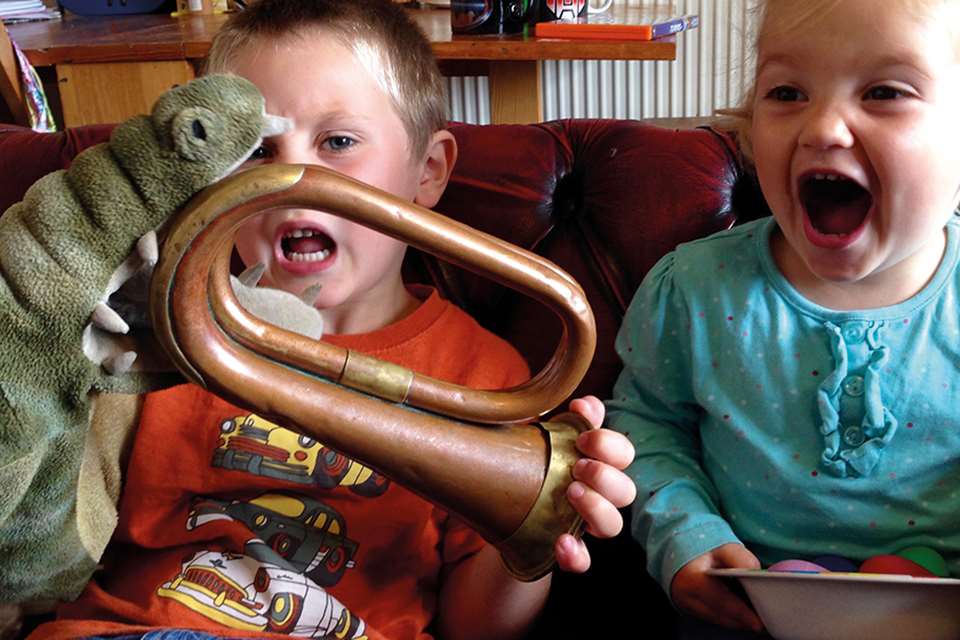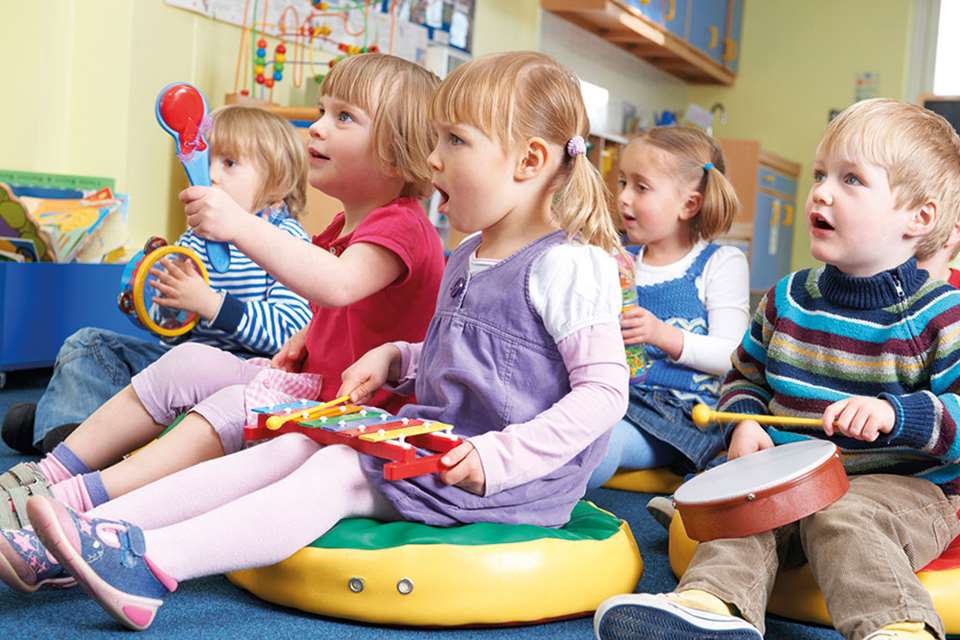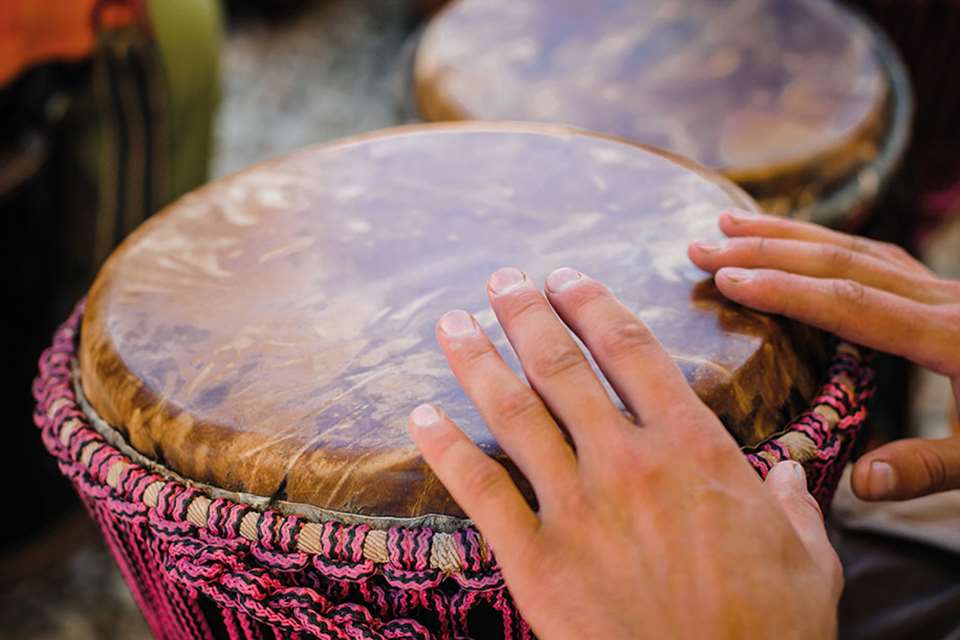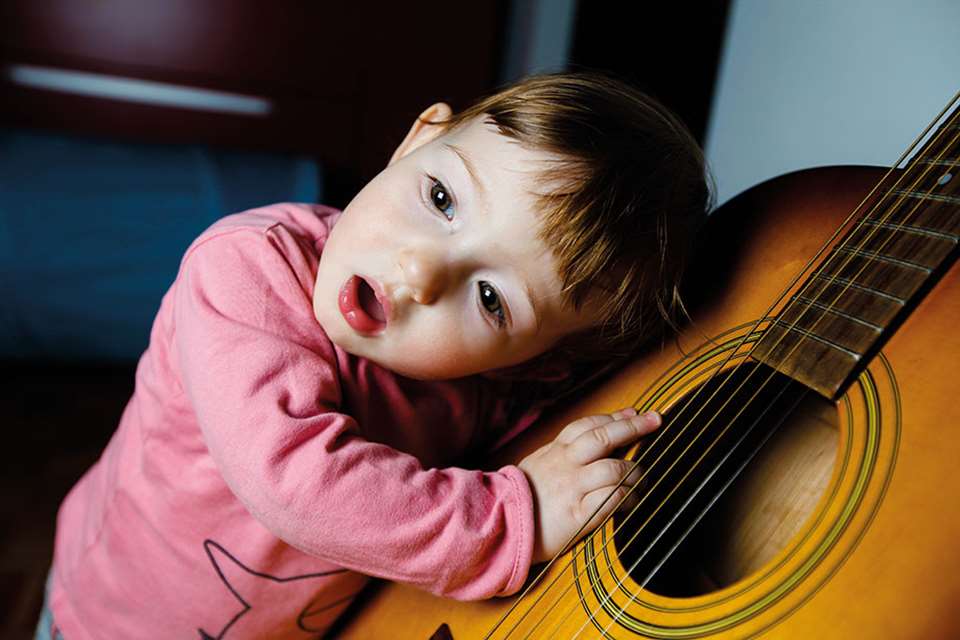Learning & Development: Music: Part 2 - Move it!
Linda Pound
Monday, October 16, 2017
Physical development and music go hand in hand, and the key to success is variety, explains Linda Pound in the second part of this series
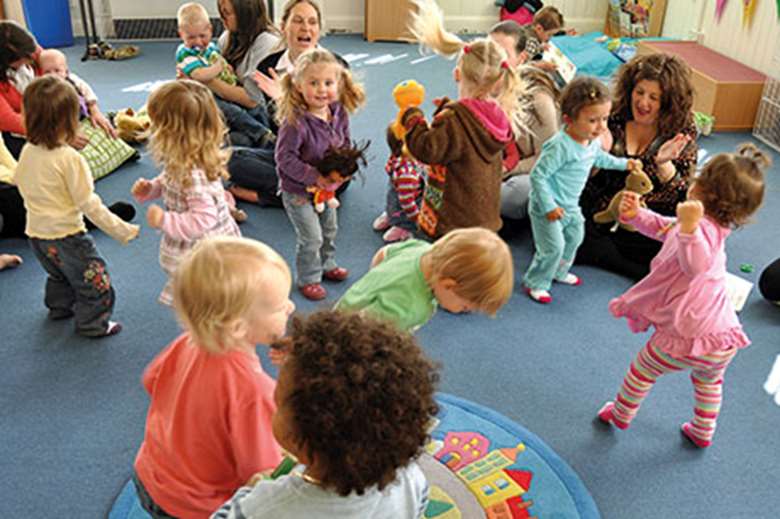
Music is physical. It is impossible to think of music and young children without thinking about physical action. As a child commented, ‘Nobody should have to sit still when there’s music. It moves and it makes you move’ (Campbell 2010). From very early in life, babies will jiggle about on hearing music – moving toes, fingers, heads or their whole bodies – often dancing before they can walk. Music for children is movement – moving their bodies is how they listen to and engage with music. This is not confined to children – in many languages there is just one word for music, dancing and singing.
Music and the associated movement contribute to children’s physical development (PD) in a variety of ways (and, conversely, physical action contributes to their musical development). It supports children’s gross motor development through developing their body awareness and sense of rhythm; their fine motor development, and their general health and self-care.
BENEFITS
Gross motor skills
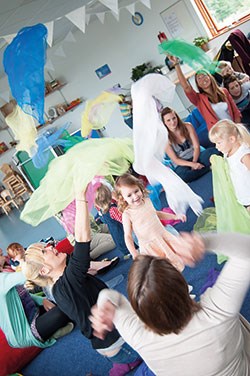 Gross or large motor skills are enhanced as children move with confidence and control, learning to negotiate spaces without bumping into others or harming themselves. This is achieved through many different types of physical action – all of which contribute to an increasing sense of body awareness.
Gross or large motor skills are enhanced as children move with confidence and control, learning to negotiate spaces without bumping into others or harming themselves. This is achieved through many different types of physical action – all of which contribute to an increasing sense of body awareness.
Body awareness involves balance, which Goddard-Blythe describes as ‘the art of not moving’; proprioception, which Eliot has described as the ‘sense of the position and movement of one’s body’; and kinaesthesis, which Woodfield describes as ‘doing more than one thing at a time in movement terms – for example, running and avoiding furniture’.
Although these elements of body awareness are developed through many types of physical play, movement in response to music and music-making makes an important contribution to that awareness – enabling children to notice and control the ways in which changes in body position can be used to produce particular effects.
Dance supports children in learning to balance, and in learning to exercise control of different parts of the body in different spaces. Similarly singing (and other vocal play and exploration) supports the development and control of the voice – a vital aspect of communication.
Steiner educational philosophy emphasises the role of music in making children aware of their bodies in time and space, believing that rhythmic movement gives learning greater meaning. Throughout our lives, we rely on a sense of rhythm to communicate better (through the use of the voice) and move more effectively and efficiently – whether walking, running, cycling or swimming.
The benefits of rough-and-tumble play in building strength and relationships, control and brain development are well-documented (Pasch 2007). Dance or rhythmic movement offers similar opportunities for challenging and joyful play, but also promotes higher-level thinking, engaging different parts of the brain. For this reason, Professor Colwyn Trevarthen, writing with colleague Jaak Panksepp, describes dance as the bridge ‘between physical exuberance and rationality’.
Fine motor skills
Music-making provides children with opportunities to develop fine motor skills. Finger rhymes and action songs require children to learn to isolate and control different parts of their body rhythmically and in particular ways and at particular points in the song. Many such songs and rhymes demand co-ordination of hands, feet and voice.
Different types of instruments call for different kinds of fine motor control. Young children are sometimes accused of having a poor sense of rhythm, but we know that very young babies can move in time to a song being sung by an adult or to music being played within their hearing.
Any apparent inability to keep time is usually due to children’s stage of motor control.
Health and self-care
Because music plays to the emotions, it motivates children to undertake joyful, apparently tireless movement – it’s no accident that so many adults choose to exercise to music or that they are prepared to dance the night away in a way that they could or would not sustain when engaged in other forms of exercise. This can be particularly helpful to encourage exercise for children who may not engage in other forms of energetic physical movement.
In relation to personal care elements of physical development, music and songs can support memory and help children to remember aspects of self-care and daily routines. Improvised versions of ‘Here we go round the mulberry bush’, for example, can be used to help children recall procedures for getting ready for lunch or for getting dressed.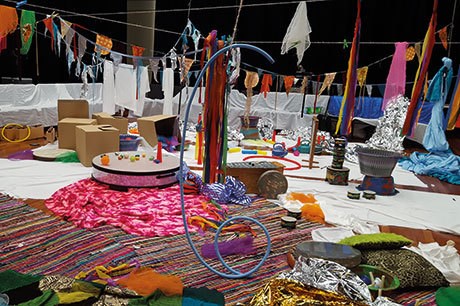
THE ADULT ROLE
Physical development can be supported by providing a movement area, where children can access recorded music, instruments, scarves, hoops and ribbons. There should be some mats to encourage floor movement, underlining the fact that dancing does not only happen on the feet. Above all there should be a mirror so that children can check out the shapes they are making as they dance. Space is an issue in most settings, as is noise. Don’t forget that some of this can happen outdoors or, although not ideal, perhaps just for one week in four.
Instruments
A variety of instruments should be provided (see box below). Instruments designed to be scraped require different actions than those designed to be struck or beaten. Holding and controlling a beater is different (and requires different competence) from holding and controlling a shaker.
The materials used for the instruments also invite children to develop different fine motor skills. Instruments such as drums and tambourines, which involve skin or other membrane materials, need to be handled more carefully than staves or tin cans. And then there are the many instruments that require a co-ordinated but different use of both hands, such as drums and keyboards.
Some instruments are easier to manage rhythmically than others. It can be difficult to make handbells, for example, ring at the right moment, but you can buy sets of handbells that are rung by simply pressing on the top of the handle – co-ordination is still required but the sound is more easily controlled.
Instruments that are worn on the body, such as wrist and ankle bells, rather than handheld, may help some children to develop great rhythmic control as their whole body movements will create a sound rather than relying on fine motor movement.
Styles and genres
It’s a good idea to broaden children’s experience of music by introducing styles and genres that the children may not have come across. Although they may find it difficult to listen and respond to unfamiliar music, it’s worth persevering. You could choose music with a common link to help the children engage with the new style – for example, offer different types of guitar music or different kinds of music about trains or the sea, though this may limit their physical responses.
Challenges
Listening to recorded music is not without pitfalls. Indiscriminate background music can be distracting, particularly when it is familiar. It may also mean that children are learning not to listen. Nicola Burke’s research (see More information) suggests that children are less likely to sing and play creatively to recorded music.
One of the factors that might inhibit children from benefiting from dance or from playing instruments is stereotyping. Even quite young children can think of dance as girly. They might also think that drumming is for boys only. Adults have a responsibility to challenge gender stereotypes – you could show video material of men dancing or, if you can afford it, or are lucky enough to have access to some dance students, you could invite them in to demonstrate their skills. Cultural stereotypes need to be similarly challenged. Parents may be able to help – either demonstrating styles of dance or by lending music and photographs.
Above all, don’t forget to play music – have fun and let children play with sounds and movements.
PRACTITIONERS: BUILDING YOUR KNOWLEDGE
Don’t forget that music and dance are natural to us all. The problem for many of us is that we become self-conscious and forget to enjoy the physicality of music. To become more confident and knowledgeable about the ways in which music can support physical development:
Become familiar with a wider range of music than you would normally listen to. Music isn’t just about classical or pop – there’s a huge range of styles or genres. You don’t have to like all of them – just listen with your whole body.
Organise a creative drumming workshop to help you and your colleagues explore rhythms. Don’t be fobbed off with a tutor who leaves you playing bump-bump-bump while he (usually) gets all the twiddly fun bits!
Have an informal dance session for the staff team – not ballet, not ballroom, just doing your own thing. Respond to the rhythms and explore what you can do – this in turn will help you to support the children to take risks and increase the challenge and variety of their musical movements.
Do an audit of the recorded music that you have, checking that you have a wide variety including music with different tempos and instruments and drawn from different cultures.
Do an audit of the instruments you have to ensure variety and to check that they are all in good order. Have broken instruments repaired or dispose of them. You can always add some junk or home-made instruments.
Review your use of recorded music and discuss this as a staff team. When do children respond most fully to music – using fine or gross motor skills?
CHOOSING INSTRUMENTS
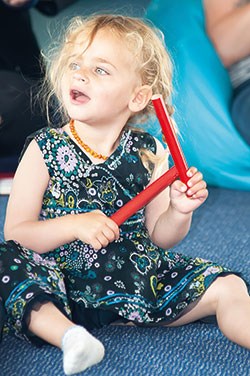 To create a music-rich environment, offer children a wide variety of materials through which they can explore and develop their understanding of their bodies and the world of sound. These should include:
To create a music-rich environment, offer children a wide variety of materials through which they can explore and develop their understanding of their bodies and the world of sound. These should include:
Instruments made from a variety of materials, including wood, skin, metal. Many instruments, especially those designed for children, are made of plastic, and while easier to clean and sometimes sturdier, they may produce a less resonant sound than instruments of other materials. They also do not teach children about the variety of sound and other sensory characteristics that they will encounter when using other materials.
Instruments that can be played in a variety of ways. This will mean including instruments that arebeaten such as triangles, xylophones and staves; instruments that are played byscraping such as violins, washboards or guiros; instruments that areplucked such as guitars and sitars; instruments that areblown such as whistles and ocarinas; and, of course, instruments that areshaken – maracas, tambourines and so on. Those that are delicate cannot be made freely available to young children but try getting adults or older children to come in and play. The sound and size of a double bass or a tuba compared with that of a musical saw or a ukulele are opportunities worth offering – see what skills the parents and neighbours at your setting have! Can small groups of children actually experience touching the instruments – with supervision? Not all instruments need to be played in exactly the way they were designed for. Playing a triangle without holding the string is not wrong, it’s just different. The only rule is that the instruments must be treated with care. Wherever possible, include instruments from different cultures and try to include some tuned instruments such as glockenspiels or chime bars.
Instruments made by you and the children. This gives children opportunities to develop physical competence and control while exploring sounds and how they are made. They could try making their own shakers; drumming on a bucket; plucking an elastic band pulled taut on an empty box; blowing over a bottle or cardboard tube; or scraping a comb across corrugated card or a stick across a spinning bicycle wheel.
Soundmakers of all descriptions – for example, scrunching up paper; banging pots and pans; hitting a metal jug with a spoon as you slowly pour out water or refill it. As one little boy declared, ‘Anything can be a musical instrument!’
More information:
A wide variety of instruments is at: www.knockonwood.co.uk or www.mesdirect.com
For world music, including some chosen for children, visit: www.putumayo.com and www.putumayo.com/product-category/putumayo-kids
ABOUT THIS SERIES
This eight-part series will explore how music:
aids early learning and development
can support learning across all areas of the EYFS
promotes the Characteristics of Effective Learning.
The series will also identify ways in which adults who lack confidence in their own musical ability or competence can become more confident.
MORE INFORMATION
Tune into Listening project (led by Nicola Burke), https://macbirmingham.co.uk/project/tune-into-listening-project
Supporting Musical Development in the Early Years by Linda Pound and Chris Harrison. Open University Press
The Well Balanced Child by Sally Goddard-Blythe. Hawthorn Press
Making Music series (Blowing;Banging;Plucking;Shaking) by Angela Aylmore. Heinemann Children’s books – gives good ideas for DIY instruments and good illustrations of conventional instruments
Songs in Their Heads by Patricia Campbell (2nd ed). Oxford University Press
‘Talking in Children’s First Language – movement!’ by Jasmine Pasch in Movement Languages in Early Childhood Education. Sightlines Initiative
‘The neuroscience of emotion in music’ by Jaak Pankseep and Colwyn Trevarthen in Communicative Musicality: Exploring the basis of human companionship by Stephen Malloch (ed) and Colwyn Trevarthen. Oxford University Press
Early Intelligence by Lise Eliot. Penguin
Physical Development in the Early Yearsby Lynda Woodfield. Continuum
With thanks to Charlotte Arculus for the use of the photographs. Charlotte is director of music and arts at Priory Children’s Centre, Great Yarmouth, and creative director of the Theatre of Adventure and Magic Adventure (www.magic-adventure.co.uk).


